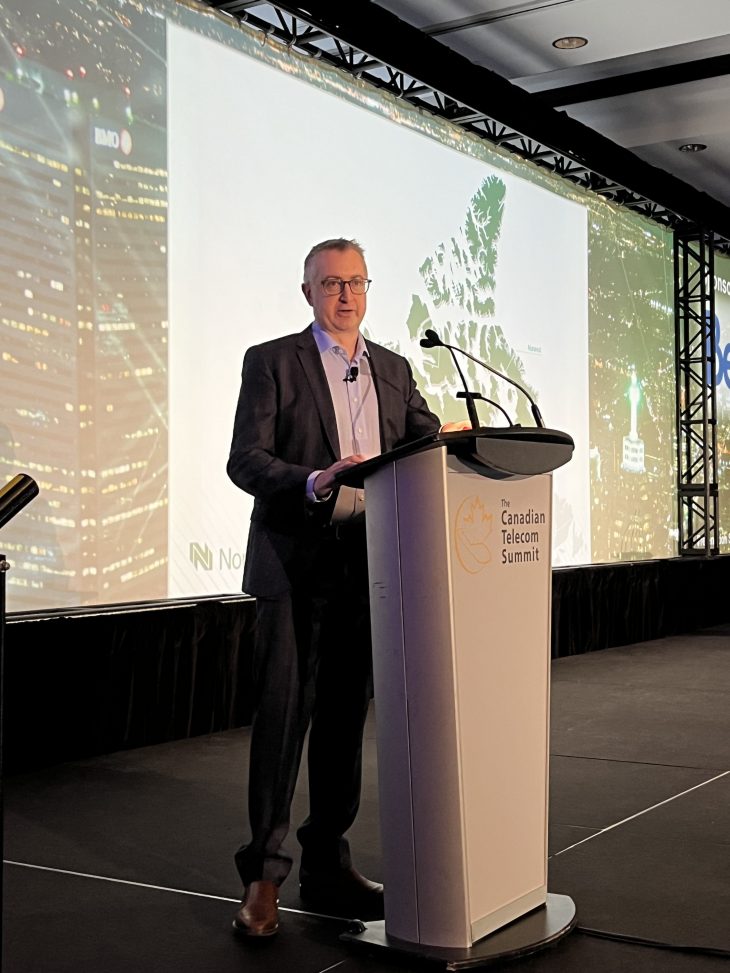
By Ken Kelley
The president of Bell subsidiary Northwestel said Tuesday that the company is aiming to increase its fiber in the north over the next 12 months, which would improve access to at least the minimum speed objective to an increasing percentage of households in the region.
On the second day of the Canadian Telecom Summit, Northwestel President Curtis Shaw noted that as recently as 2016, not one northern household met the CRTC’s universal service objective of 50 Mbps download with unlimited data. Today, he said more than 22,000 northern homes — over 80% of households — not only have access to that standard, but exceed it.
Shaw said the company aims to improve on its fiber network over the next 12 months, boosting the percentage of households to 90% with access to those speeds and beyond in the Yukon and Northwest Territories.
“Seven years ago, these communities had access to five megabit-per-second internet, and today, those same communities can order 500 meg[abit per second], fully symmetrical [same upload as download speed], fiber-based internet with unlimited data for the first time,” he said.
In the time since assuming the top role at Northwestel in 2018, Shaw said he made it his mission to help bring today’s technologies to what is arguably one of Canada’s most geographically challenging regions.
A native of Saskatchewan, Shaw started with the communications provider in 1996. During his tenure thus far, he has brought fiber-to-the-home technology to more than 20 remote northern communities, helping make the Yukon and Northwest Territories among the most connected jurisdictions in Canada.
He spoke of the unique challenges and opportunities he sees in his role during an address at CTS on Tuesday.
“When you’re in Downtown Vancouver, or Downtown Toronto, connecting 100 households might involve running fiber down a city block,” Shaw told the audience. “In the Yukon, expanding fiber access to just 125 homes in the community of Ross River will require us to extend our fiber network by over 200 kilometers. You can imagine the logistical challenges of bringing fiber to the home in some of our communities.”
In other areas such as Cambridge Bay in Nunavut, Shaw said the surrounding geography means running the necessary cables to improve satellite, the completion of station upgrades or even erecting a new LTE cellular tower isn’t as cut and dried as other parts of the country. He notes that for Cambridge Bay, materials are shipped by sea barge in the summer months, and usually constructed the next year, while in other communities across the three territories, key material must be lined up and delivered in the winter in advance of next summer’s construction season.
Shaw also discussed the highly-publicized Shared Pathways Partnership, which was revealed earlier this year. The partnership, the first of its kind in Canada, was developed in association with 13 First Nation development corporations in the Yukon.
“When consulting with First Nation partners in the Yukon, they celebrated our efforts to really close the digital divide with the rest of Canada. But some of the feedback we received, was that they didn’t want to simply be beneficiaries of better service; they wanted to take part in the economic benefits of these investments.”
He said the partnership affords greater decision making among the First Nations communities taking part, as well as the opportunity for them to take full ownership of the fiber assets in the territory.
“We believe that strong connections create stronger communities and through talking to many of our communities, they were asking for faster internet as well as more affordable internet. But additionally, the partnership provides direct economic benefits, because we are leasing the network back from First Nation development corporations and they will see some economic benefit from this for the next 20 years. We’re in a time of self-government and land claims, and these kinds of opportunities push the narrative forward in terms of reconciliation between corporate Canada and the First Nations’ peoples of this country.”
Photo of Curtis Shaw
Correction: A previous version of this story said Northwestel was eyeing doubling the number of households with 50/10 speeds. In fact, Shaw is not doubling its overall fiber, but it is aiming to increase its fiber over the next 12 months and increase the percentage of households in the region with access to the minimum objectives speeds and beyond to 90%.



